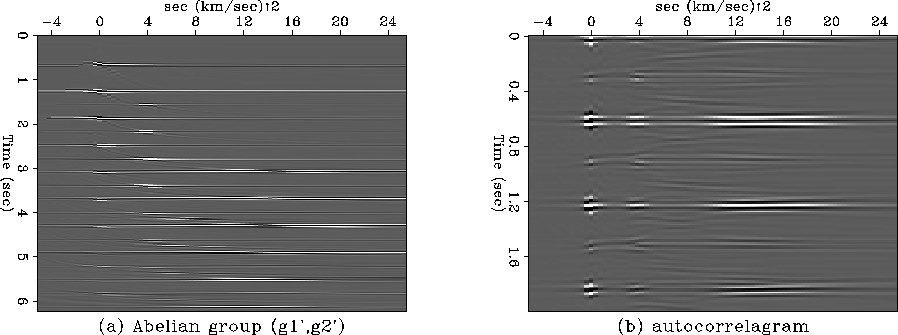 |
Figure 3 (a) is the Abelian group attributes (g1',g2'), (b) is its autocorrelogram. Water-related reverberations are periodic and lie directly under each other on the g1'=T axis.
 |
We can apply gapped predictive deconvolution on this (g1',g2') in Figure 3a. Conjugate mapping all the way from the deconned Abelian group back to the space-time domain gives the water-related reverberations attenuated section.
Two problems with this mapping are that it requires two more (forward and conjugate via (T,1/Vnmo2) ) mappings, while the amplitude in the (g1',g2') domain is less regular than in the second method described below. So we move on to the second mapping method, a direct one.
The other way to go to (g1',g2') is to do velocity transform mapping directly from the space-time domain. The conjugate mapping from (g1',g2') to material parameters consists of:
Considering the velocity uncertainty, for a point
in (g1',g2') domain, we use also its left and right neighbors along the
g2' axis to invert for material parameters, yielding a T, and three
velocities squared.
We apply velocity transform by NMO Kirchhoff summation
over the hyperbola strip defined by the three velocities squared.
The weight given to each summing element is defined by a triangle weighting
function, an approximate to a Gaussian function (Jedlicka, 1989).
The apex of the triangle is at the NMO time of the median velocity squared.
The area under the triangle is ![]() ,i. e., we are honoring the 2-D Green's function.
The result of summation gives the value at
the corresponding point in (g1',g2') domain.
The conjugate mapping is the spraying out of the
point value in (g1',g2') domain into the NMO hyperbola strip
Kirchhoff trajectory in space-time domain (Claerbout, 1991).
One caution is that the coordinate g2'=0 must be sampled
because it directly samples the water bottom multiples.
,i. e., we are honoring the 2-D Green's function.
The result of summation gives the value at
the corresponding point in (g1',g2') domain.
The conjugate mapping is the spraying out of the
point value in (g1',g2') domain into the NMO hyperbola strip
Kirchhoff trajectory in space-time domain (Claerbout, 1991).
One caution is that the coordinate g2'=0 must be sampled
because it directly samples the water bottom multiples.
The problem with this velocity transform mapping method
arises from the different
velocity sensitivity in the relation Vnmo2 = g2'/g1' + Vwater2
between shallow and deep parts. When g1'=T is small,
a small change in g2' results in a big change in Vnmo2.
We discard the negative Vnmo2 as computed.
As a result, the velocity is coarsely sampled at the shallow part, whereas
the velocity is densely sampled at the deep part.
We apply a weighting function 1/Vnmo2 to balance between the
number of small and
large velocity values used, and to underweight the ridiculously high
velocities as computed at the shallow part.
And because the 2-D Green's function favors the near-offset strongly, after
conjugate inverse velocity transform, the far offset data is attenuated.
We include an extra weighting function ![]() ,
where
,
where ![]() is the
Kirchhoff obliquity factor.
From our experiences, the results
are acceptable when T>0.3 second.
is the
Kirchhoff obliquity factor.
From our experiences, the results
are acceptable when T>0.3 second.